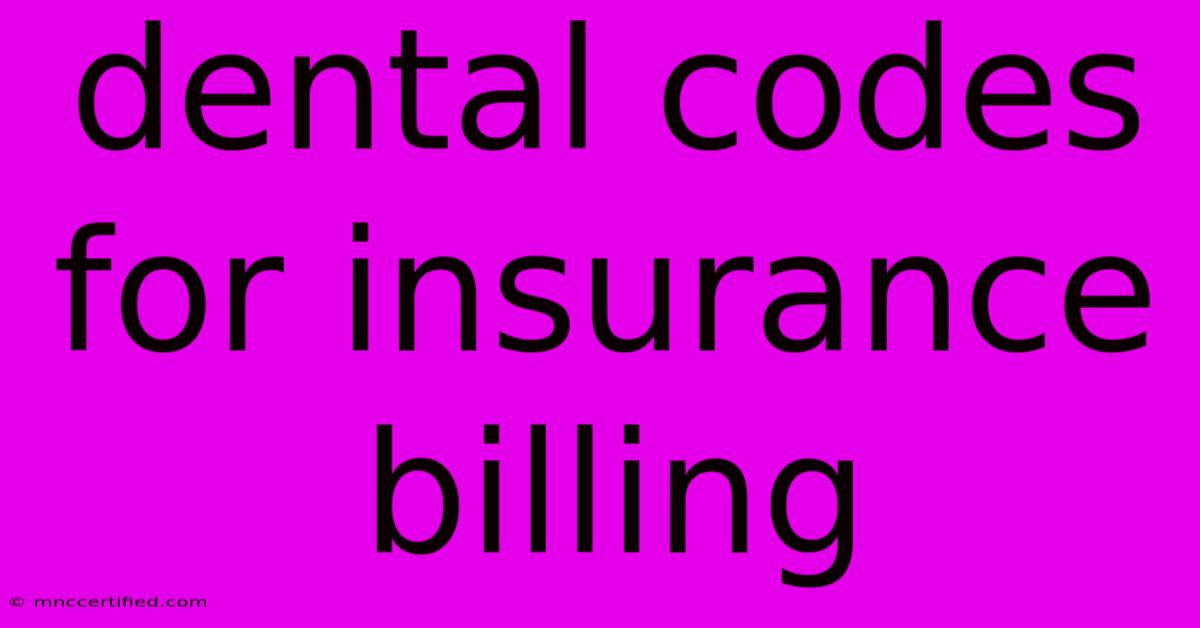Dental Codes For Insurance Billing

Table of Contents
Mastering Dental Codes for Insurance Billing: A Comprehensive Guide
Understanding dental codes is crucial for smooth insurance billing and efficient practice management. This guide provides a comprehensive overview of dental codes, their structure, and how to use them effectively to ensure accurate claims processing and timely reimbursements. We'll explore common code sets, how to avoid common mistakes, and resources for staying updated on the latest coding changes.
Understanding the Dental Coding System
Dental insurance billing relies on a standardized system of alphanumeric codes that describe the procedures and services provided to patients. The most widely used system is the CDT (Current Dental Terminology) code set, maintained by the American Dental Association (ADA). These codes are essential for communicating with insurance companies and ensuring accurate reimbursement.
Key Components of Dental Codes
Dental codes are typically composed of several parts that provide specific information about the procedure:
- Main Category: This indicates the general type of service (e.g., examination, restorative, endodontics).
- Subcategory: This narrows down the specific procedure within the main category.
- Specific Code: This provides a unique identifier for each individual procedure.
For example, a code like D0120 (Periodic oral examination) clearly indicates the type of service (examination) and the specific procedure (periodic oral examination). Understanding this structure is vital for selecting the correct code for each service rendered.
Common Dental Code Categories and Examples
The CDT code set encompasses a wide range of procedures. Here are some common categories and example codes:
1. Examination Codes (D0100-D0150):
- D0120: Periodic oral examination
- D0140: Comprehensive oral examination
- D0150: Limited oral examination
These codes represent various levels of oral examinations, from routine checkups to more detailed assessments.
2. Preventive Codes (D1110-D1210):
- D1110: Adult prophylaxis
- D1201: Topical fluoride application - adult
- D1330: Sealants - any surface
These codes cover preventive services aimed at maintaining oral health and preventing disease.
3. Restorative Codes (D2100-D2999):
- D2140: Amalgam – restoration – one surface
- D2391: Composite resin – posterior – one surface
- D2740: Crown – porcelain fused to high noble metal – anterior
These codes cover procedures related to restoring damaged or decayed teeth.
4. Endodontic Codes (D3140-D3499):
- D3160: Pulpectomy
- D3220: Endodontic retreatment
- D3620: Root Canal
These codes describe procedures related to the pulp and root canal system of the tooth.
5. Periodontics Codes (D4100-D4999):
- D4341: Scaling and root planing – four or more teeth
- D4910: Gingivoplasty
- D4920: Gingivectomy
These codes relate to procedures for treating gum disease (periodontitis).
Avoiding Common Dental Coding Mistakes
Inaccurate coding can lead to denied claims, delayed payments, and even audits. Here are some common mistakes to avoid:
- Using outdated codes: Always ensure you are using the most current version of the CDT code set.
- Coding for services not provided: Never code for a procedure that wasn't actually performed.
- Incorrect code selection: Double-check the code description to ensure it accurately reflects the service.
- Missing or incomplete information: Ensure all necessary information, such as diagnosis codes, is included on the claim form.
Staying Updated on Dental Code Changes
The ADA regularly updates the CDT code set. Staying current is crucial for accurate billing. Resources include:
- ADA website: Check the official ADA website for the latest CDT code updates and publications.
- Dental billing software: Many software programs automatically update codes, simplifying the process.
- Professional development courses: Attending continuing education courses can help you stay abreast of changes in dental coding and billing practices.
Utilizing Resources for Efficient Dental Billing
Effective dental billing involves more than just understanding codes. Consider these additional factors:
- Dental billing software: Software can automate many aspects of the billing process, improving efficiency and reducing errors.
- Claims submission procedures: Familiarize yourself with the specific requirements of each insurance provider.
- Regularly review claims: Monitor claim status and address any denials promptly.
By mastering dental codes and employing efficient billing practices, you can significantly improve your practice's financial health and ensure timely reimbursements. Remember, accuracy and attention to detail are paramount for successful dental insurance billing.

Thank you for visiting our website wich cover about Dental Codes For Insurance Billing. We hope the information provided has been useful to you. Feel free to contact us if you have any questions or need further assistance. See you next time and dont miss to bookmark.
Featured Posts
-
Big Brother Housemate Favorite To Win
Nov 16, 2024
-
General Liability Insurance Kansas
Nov 16, 2024
-
Best Boat Insurance South Carolina
Nov 16, 2024
-
Phone Number For Freedom Insurance
Nov 16, 2024
-
Childers On The Road Tour New Orleans Date
Nov 16, 2024